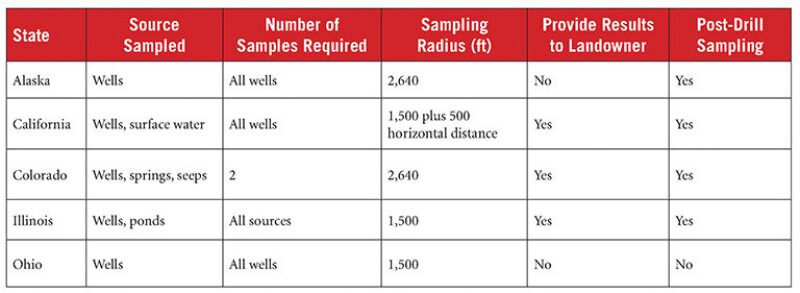The rise of unconventional shale exploration and production in the United States has led to a growing concern over its environmental impact, particularly with regard to the contamination of groundwater sources such as ponds, streams, and private water wells.
As state governments seek to further regulate hydraulic fracturing activities, operators have developed programs to document predrilling groundwater conditions through baseline sampling, an expert said.
In a presentation held by the SPE Gulf Coast Section’s Water and Waste Management study group, Ryan Leatherbury discussed the lessons learned from his experience in conducting baseline groundwater sampling in US shale regions. Leatherbury is a client service manager at Weston Solutions, an environmental services company.
An operator’s reasons for taking groundwater samples typically fall within the following categories:
- Risk management. As they provide documentation of groundwater conditions before drilling, samples are often effective in mitigating the risks that accompany hydraulic fracturing.
- Regulatory drivers. Baseline sampling is required in Alaska, California, Colorado, Illinois, Maryland, Pennsylvania, West Virginia, and Wyoming. In Ohio, operators must submit analytic sampling results with their applications for drilling.
- Stakeholder engagement. Operators who take samples demonstrate their commitment to not contaminating landowners’ water sources. Leatherbury referred to this as a “good fences, good neighbors” policy.
Defining the geographic scope of a sampling program provides insurance for companies should they face a post-drilling legal dispute. Leatherbury said operators should consider local logistics in the planning stages.
If an operator plans to take samples in different geographic areas, it should determine what elements of the sampling program should remain consistent across different areas and which elements should be unique to each area.
“When you look back on the reasons why you do this work, and the reasons for what you’ve done are consistent across all of your operations, they become very interesting in a court of law. Understanding why you’re [taking baseline samples] is going to drive this,” Leatherbury said.
Operators should make initial contact with the landowners by phone or in person and seek written permission to test water sources on their property. They must be ready to explain why they are collecting samples and they must be willing to perform post-drilling samples.
Leatherbury said providing landowners with analytical test results—an act that is not required by every state—is also an important step to maintaining transparency in the process.
“If you’ve got the data and they don’t, then they’re going to suspect something,” he said. “If you find something in that water well, you’re darn right you want them to know about it, particularly if it’s something hazardous. If there’s something that’s already there before you got there, you want the landowner to know because that’s going to keep them from coming back in 2 years and saying, ‘Hey, you put something in my well.’”
Regulations on baseline sampling vary significantly from state to state (Table 1). Some states such as Alaska and Ohio require operators to collect sources only from nearby wells, while other states such as California require the sampling of wells and surface water. Some states require testing of all sources within a 2,640-ft (0.5-mile) radius of the wellsite, while others require testing within a 1,500-ft (0.3-mile) radius.

Leatherbury said the inconsistencies in state regulations show that risk management is the most important driver behind baseline sampling programs.
“I would love for this program to be 100% driven by science, but when you come and look at something like [the state regulations], and you tell me there’s science involved? There’s no consensus. This program is about risk management. It’s got some science involved, but it’s about risk management. We’re not looking for contamination. All we’re looking for is, in general, if the usability of that water changed before and after operation,” he said.

